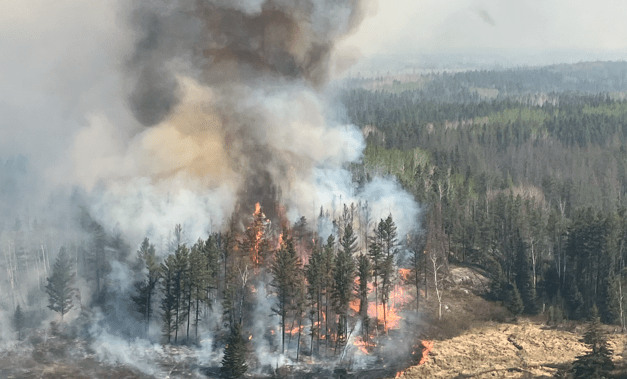Wildfire season is here — and experts stress that Canadians and homeowners need to be more prepared in order to have the best chance at mitigating dangers to themselves and their properties.
As dozens of wildfires rage across several provinces, including Manitoba, Saskatchewan and Alberta, all eyes are now on what this year’s wildfire season could bring, and how Canadians can prepare amid increasingly expensive and frequent natural disasters.
“Whether it’s for wildfire or flood or some other peril, we should not be surprised that we’re breaking records,” say Blair Feltmate, a professor at the University of Waterloo and head of the Intact Center on Climate adaptation.
“Climate change is irreversible, period. The most we can do is slow it down — we can’t stop it.”

How bad is the situation right now?
According to the Government of Canada’s website, there are currently roughly 30 uncontrolled wildfires, and 35 that are reported as “controlled,” with the majority located in parts of the Prairies.
The Manitoba government has declared a state of emergency as thousands evacuate their homes.
Saskatchewan also has several evacuation orders and restrictions in place.
In Alberta, the wildfire authority has issued a red-flag watch indicating an increased risk of fire danger, with residents of some communities in the province also evacuating.
“The wildfire season in Canada now starts about a week earlier and runs a week later than was the case 70 years ago,” says Feltmate, adding, “That’s being driven by a variety of factors, all of which fall under a changing climate — a warming climate.”

Get daily National news
Get the day’s top news, political, economic, and current affairs headlines, delivered to your inbox once a day.
Feltmate also cites insurance claims data, which he says is a clear sign of how these disasters are having a financial impact on Canadians and businesses.
“From about 1983 up to 2008, the insurance industry in Canada could count on paying out between about $250 to $450 million per year in catastrophic claims due to things like flooding, wildfire, windstorms, hailstorms, all rolled in,” he says.
From 2009 onwards, he added, “Claims are in the order of about $2.8 to $2.9 billion per year, with 2024 alone totalling $9.1 billion.”

What can you do to protect your home?
There are several cost-effective ways to protect a home from disasters like wildfires, and Feltmate says these measures can reduce the probability of losing one’s house by 50 to 75 per cent.
The Government of Canada outlines a few recommendations for how to minimize the damage from potential wildfires, and they recommend also consulting with the local fire department or a qualified engineer about making homes more fire resistant.
Some of the recommendations include removing hazards like dried branches, leaves and debris from the surrounding areas, keeping a working sprinkler available, ensuring proper smoke and carbon monoxide detectors are installed, and knowing how to turn off utilities if needed.
Feltmate also offered additional ways to help reduce risks.
“If you have shrubs within 1.5 metres of your home, remove them. Put attractive river stone in or something like that which is non-burnable material,” he said.
Feltmate also stresses to “keep firewood 10 metres away from the house, even if it seems less convenient,” as well as “making sure eavestroughs are clear of any dry debris like pine-needles, leaves, and twigs that may ignite if an ember lands in the them.”
Then, for homeowners who are able to spend more to reduce fire risk, Feltmate recommends replacing wooden fences around properties with metal chain-link or other types of non-flammable fencing, as well as removing any large conifer trees that are 10 metres or less from the home.
“When these needle-bearing trees ignite, they burn very quickly and release a tremendous amount of heat in a short period of time, and if they’re in close proximity to the house, that heat will transfer the house and the house will burn down,” he explained.
Building porches and balconies, as well as roofs, siding and walls out of non-combustible materials including stucco, metal, stone, cement fibreboard, and asphalt shingles where applicable can also help reduce risk.
In the case of the roof being modified, which can sometimes be one of the most costly single projects for a home, Feltmate says the piece of mind for the price paid now may be worthwhile should a wildfire occur.
“Some of the most expensive things you can do to mitigate fire risk are pretty good deals.”

Are you ready for an evacuation order?
The Government of Canada also has a list of guidelines available to help residents prepare and respond to wildfires including having a plan for each member of the household and packing emergency supply kits well in advance in case of a need to evacuate.
Those include practicing your evacuation route, considering any special requirements of family members or pets if you have to leave your home, and making sure your mobile devices are compatible with Alert Ready, the national emergency alert system.
The biggest challenge, as Feltmate points out, is getting information out to homeowners so they are better prepared.
“We know the solutions to the problem that can be deployed in this case at the level of the house – that’s the good news,” says Feltmate.
“The bad news is we’re not getting this information out to homeowners quickly enough — that’s the challenge.”
© 2025 Global News, a division of Corus Entertainment Inc.
As wildfires rage, what can you do to prepare and reduce your risks?





